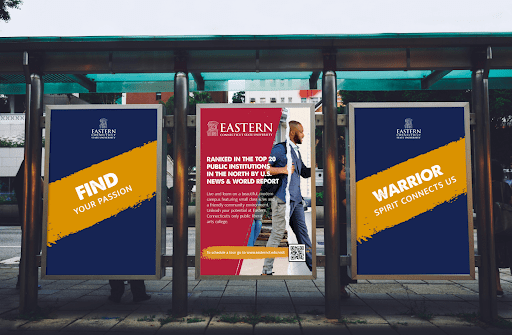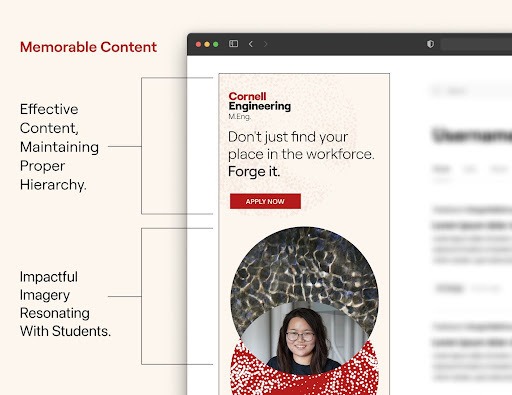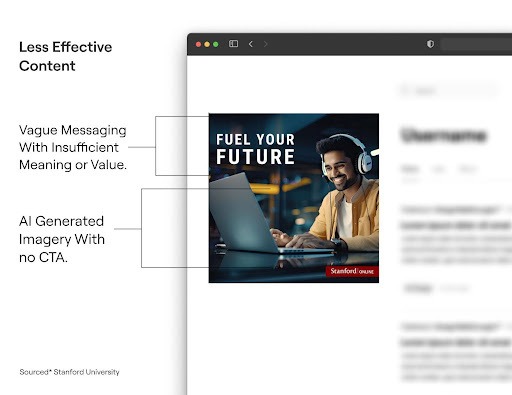This article, written from a dual perspective of an adjunct professor and agency designer, highlights the challenges of marketing fatigue among students overwhelmed by generic higher education outreach. It emphasizes the need for universities to adopt research-based value propositions that clearly communicate unique opportunities and personalize messaging to resonate with students’ aspirations for real-world experiences and mentorship. Effective strategies involve amplifying the institution’s core “why,” utilizing authentic and emotionally resonant visuals, and leveraging social media platforms with relevant, story-driven content. Ultimately, successful higher education marketing requires collaboration between universities and agencies to convey a distinct promise beyond a logo, ensuring students envision their unique journey.
As an Adjunct Professor in the Art & Design Department at Central Connecticut State University and a designer at Rebellion Group, I’m in a unique position to analyze how colleges and universities shape their brands and the influence of their messaging, which is why I invite you to join me in considering what’s missing in most higher ed marketing enrollment approaches today.
Addressing Marketing Fatigue
Online U reports that there are almost 6,000 colleges and universities in the U.S., presenting students with a wide range of choices as they embark on their next academic journey. These institutions offer various amenities, such as clubs, activities, and comprehensive four-year programs. However, according to the students I’ve discussed this with, those outreach efforts — often containing similar messaging — leave them feeling overwhelmed. The sheer volume of advertisements, emails, direct mail, and other promotional content coming at them from so many schools creates a sense of “marketing fatigue” that ultimately reduces their effectiveness.
Here’s an example: I recently read an article1 about how colleges can break through marketing clutter. The author noted that his son received recruiting materials from more than 300 schools, part of which amounted to piles of brochures and postcards that he ended up simply throwing away. When he asked his son why, he said: “They all say the same thing.”
When faced with a decision as significant as choosing a college, students seek an experience tailored to their individual needs, both in terms of what educational institutions offer and how they’re marketed. A standardized approach does not cater to everyone. Marketing strategies should be rooted in research-based value propositions that form the basis for narratives that resonate with students’ aspirations and requirements.
Those strategies need to answer these key questions:
- How can educational institutions address the issue of information overload?
- How does our marketing help students envision their success?
- How do we make custom experiences for incoming students?
- In what ways do we make it easy for parents to support students’ school choices?
The differentiation we help create should empower students to confidently apply and imagine what their journeys will entail.
Communicating a Unique Opportunity
One common denominator I see from agency and school perspectives is that, while most universities offer words of empowerment, the messaging tends to be generic. Agencies use data, research, and metrics, but how does that translate to what students need and want? How do agencies’ visual directions and strategies represent those desires? How do we appeal to students, and — most importantly — why? We use traditional marketing vehicles such as paid media and print marketing, but as creatives, what do we need to do to communicate with students to show that our school is the right one to give them the social experiences and career backgrounds they seek?
In general, how does our marketing and messaging tell prospective students what’s truly unique about a school and how it fits into their lives. It’s about two critical aspects: clearly communicating the value (and values) offered by the institution and building creative — particularly social media — that resonates personally with them.
Putting Value Front and Center
Students are hungry. They want education beyond textbooks and tests that validate their knowledge. Students seek hands-on, real-world experiences. Beyond technical subject matter expertise, they value experiential, immersive mentorship to kickstart their careers and view that as key to their growth.
As an educator, it’s my role and duty to foster, support, and mentor students to be their best selves by giving them the tools and experience they need to pursue their passions and professional goals. Part of the way I achieve that is by offering value to my students based on my work experience. To that end, I recently hosted an on-campus roundtable discussion featuring my Rebel colleagues focused on expectations for a design career called “Graduating, What Now?” Students had the opportunity to ask questions, gain feedback for their portfolios, and learn more about the field from industry matter experts. That was my answer to the value they seek; to the “why Central Connecticut?” question.
From an agency standpoint, our job is to amplify that “why” and effectively position that promised value. Our metrics and data (including student feedback) work to create the messaging that gets students enrolled. That means we need to stay ahead of the curve regarding trends in higher education. For example, data tells us2 about the importance of aligning program offerings to the increasing demand for market skills and that assessment and feedback are necessary to foster students’ growth. That information, in turn, informs the way we create messaging built around both the employment opportunities across verticals and the available mentorship and guidance at the institution we’re working for.
In short, the values of a university can, and should, align with the agency’s messaging. How do we bring this back to branding and messaging? The answer is simple: agencies need to help universities visually showcase their values, personalities, and promises. Aligning creative with schools’ core values and actions validates students’ needs and desires. In practice, that might mean, for example, using thoughtfully selected, authentic photos instead of stock and providing messaging relating to students’ emotions and aspirations is the key to developing memorable creative.
The bus stop kiosk Rebel created for Eastern University, shown below, illustrates how we put the school’s values on clear display, with a strong focus on passion and connection, along with a validating message from a major media source.

Done right, that positioning results in enrollments, satisfying students, schools, and agencies.
Making Media Personal
In terms of social media, TikTok, Instagram, and Threads represent “ground zero” for Gen Z and A communication, offering popular formats to post reels, posts, and shorts, so it makes sense for schools to meet them in their own medium. Social media is a powerful force to reach many, as it is open-source access with influencers and users, but messaging on these platforms requires technical brand consistency. Relating back to what our data tells us,2 relevant content is vital in providing value to the end user.
Socials need to relate, tell a story, and provide value to the end-user by tying the core benefits the school offers back to the student’s needs and desires. Simply posting a stock image with an “Apply Now” CTA won’t work — it’s too generic and does not provide meaning. Targeting emotions helps users better resonate with a brand because people remember experiences and not generic “fluff” messages with stock photos. It’s that personal connection that causes the user to act.
The examples below illustrate how the right creative can help push those “emotive” buttons and draw people more closely to a school. Between powerful messaging and relatable imagery, the content we developed for Cornell simply works harder to resonate with prospective students.


Enrollment Marketing is About Teamwork
Living on both sides of the higher education table has shown me that brands do play a major role in students deciding which school to attend. However, universities and agencies need to work together to ensure that the visual messaging they create carries more than just a logo. It needs to convey a promise to students. It should clearly communicate that this institution provides the education, mentorship, and environment necessary to prepare students for making a distinctive impact on the world.
Every school’s job is to provide those opportunities, and every agency needs to help them create a brand, story, and messaging that exemplifies their values in a way that separates them from the competition.
— Kevin Skrocki, Graphic Designer
1 Medium, “Colleges Can Break Through the Clutter by Marketing in Groups,” November 9 2023.
2Journal of Information Systems & Operations Management, Vol. 17.2, December 2023, Purcărea, Ioan-Matei.